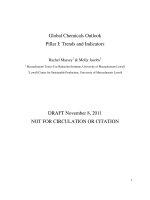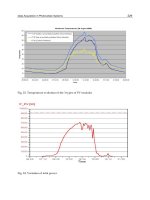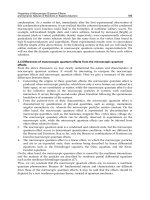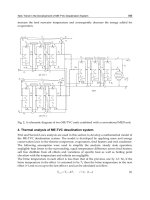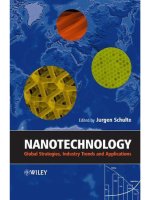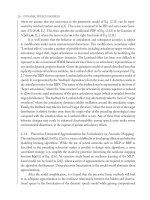Nanotechnology Global Strategies, Industry Trends and Applications phần 9 doc
Bạn đang xem bản rút gọn của tài liệu. Xem và tải ngay bản đầy đủ của tài liệu tại đây (188.76 KB, 20 trang )
on fluorescent polymer nanofibre films have recently been reported [58, 59].
Preliminary results indicate that the sensitivities of nanofibre films to detect ferric
and mercury ions and a nitro compound (2,4-dinitrotulene, DNT) are two to three
orders of magnitude higher than sensitivities obtained from thin film sensors. A
single nanofibre coated with two metals at different segments will create a junction,
which can be made into a thermocouple to detect inflammation of coronary arteries
with extremely fast response times [60]. Such nanothermocouples can be inserted
into a cell to monitor the metabolic acticvities at various locations within the cell.
Furthermore, multiple nanothermocouples can be circumferentially mounted on a
catheter balloon to allow mapping of the arterial wall temperature [61].
8.8 Conclusion
Nanofibres and nanofibre structures are relatively recent materials. A number of
publications have appeared in recent years on specific polymeric nanofibers, their
processing methods and uses. See Figure 8.7 for a summary of next-generation
Figure 8.7 Summary and advantages of polymeric nanofibres for next-generation
applications
Next-Generation Applications for Polymeric Nanofibres 145
applications. However, there are several areas that require attention for further
development of the field. Potential applications of polymer nanofibres have been
recognized, but are mainly limited to the laboratory at present. Much greater efforts
will be required to commercialize these applications. As a result, research and
development of polymer nanofibres will continue to attract the attention of scien-
tists in the near future.
Acknowledgement
The authors acknowledge the efforts by M. Kotaki, R. Inai, C. Y. Xu and F. Yang of
the Biomaterials Lab at NUS, and Professor A. Yarin of Technion-Israel Institute
of Technology.
References
1. Martin et al., US Patent 4044404, 1977.
2. How T. V., US Patent 4552707, 1985.
3. Bornat A., US Patent 4689186, 1987.
4. Martin et al., US Patent 4878908, 1989.
5. Berry J. P., US Patent 4965110, 1990.
6. Stenoien et al., US Patent 5866217, 1999.
7. Scopelianos A. G., US Patent 5522879, 1996.
8. Athreya S. A. and Martin D. C., Sensors and Actuators, 72 (1999) 203.
9. Buchko C. J., Chen L. C., Shen Y. and Martin D. C., Polymer, 40 (1999) 7397.
10. Buchko C. J., Slattery M. J., Kozloff K. M. and Martin D. C., Journal of Materials Research, 15 (2000)
231.
11. Buchko J., Kozloff K. M. and Martin D. C., Biomaterials, 22 (2001) 1289.
12. Yang F., Murugan R., Ramakrishna S., Wang X., Ma Z. W. and Wang S., Biomaterials, 25 (2004) 1891.
13. Migliaresi C. and Fambri L., Macromolecular Symposia, 123 (1997) 155.
14. Laurencin C. T., Ambrosio A. M. A., Borden M. D. and Cooper J. A. Jr, Annual Reviews of Biomedical
Engineering, 1 (1999) 19.
15. Huang L., McMillan R. A., Apkarian R. P., Pourdeyhimi B., Conticello V. P. and Chaikof E. L.,
Macromolecules, 33 (2000) 2989.
16. Fertala A., Han W. B. and Ko F. K., Journals of Biomedical Materials Research, 57 (2001) 48.
17. Stitzel J. D., Pawlowski K. J., Wnek G. E., Simpson D. G. and Bowlin G. L., Journal of Biomaterials
Applications, 16 (2001) 22.
18. Boland E. D., Wnek G. E., Simpson D. G., Pawlowski K. J. and Bowlin G. L., Journals of
Macromolecular Science, A38 (2001) 1231.
19. Nagapudi K., Brinkman W. T., Leisen J. E., Huang L., McMillan R. A., Apkarian R. P., Conticello V. P.
and Chaikof E. L., Macromolecules, 35 (2002) 1730.
20. Li W. J., Laurencin C. T., Caterson E. J., Tuan R. S. and Ko F. K., Journals of Biomedical Materials
Research, 60 (2002) 613.
21. Matthews J. A., Wnek G. E., Simpson D. G. and Bowlin G. L., Biomacromolecules, 3 (2002) 232.
22. Xu C. Y., Inai R., Kotaki M. and Ramakrishna S., Biomaterials, 25 (2004) 877.
23. Lim T. C., Kotaki M., Yong T. K. J., Yang F., Fujihara K. and Ramakrishna S., Materials Technology,
19 (2004) 20.
24. Ignatious F. and Baldoni J. M., PCT/US01/02399, 2001.
25. Kenawy E. R., Bowlin G. L., Mansfield K., Layman J., Simpson D. G., Sanders E. H. and Wnek G. E.,
Journal of Controlled Release, 81 (2002) 57.
146 Nanotechnology
26. Zong X., Kim K., Fang D., Ran S., Hsiao B. S. and Chu B., Polymer, 43 (2002) 4403.
27. Coffee R. A., PCT/GB97/01968, 1998.
28. Martindale D., Scientific American, July 2000, pp. 34–36.
29. Smith D. and Reneker D., PCT/US00/27737, 2001.
30. Smith D., Reneker D., Schreuder-Gibson H., Mello C., Sennett M. and Gibson P., PCT/US00/27776,
2001.
31. Graham K., Ouyang M., Raether T., Grafe T., McDonald B. and Knauf P., Fifteenth Annual Technical
Conference and Expo of the American Filtration and Separations Society, Galveston, Texas, 9–12
April 2002.
32. Kosmider K. and Scott J., Filtration and Separation, 39 (2002) 20.
33. Ward G. F., Filtration and Separation, 38 (2001) 42.
34. Emig D. et al., US Patent 6395046, 2002.
35. Tsai P. P., Gibson H. S. and Gibson P., Journal of Electrostatics, 54 (2002) 333.
36. Angadjivand S. A., US Patent 6375886, 2002.
37. Chamberlain G. and Joyce M., Design News, 20 August 1990.
38. Nadis S., Scientific American, 10 (1999) 74.
39. Gibson P., Schreuder-Gibson H., and Pentheny C., Journal of Coated Fabrics, 28 (1998) 63.
40. Gibson P., Schreuder-Gibson H., and Rivin D., Colloids and Surfaces, A187/188 (2001) 469.
41. Schreuder-Gibson H., Gibson H., Senecal K., Sennett M., Walker J., Yeomans W., Ziegler D. and
Tsai P. P., Journal of Advanced Materials, 34 (2002) 44.
42. Kim J. S. and Reneker D. H., Polymer Composites, 20 (1999) 124.
43. Dzenis Y. A. and Reneker D. H., US Patent 6265331, 2001.
44. Bergshoef M. M. and Vancso G. J., Advanced Materials, 11 (1999) 1362.
45. Park C., Ounaies Z., Watson K. A., Pawlowski K., Lowther S. E., Connell J. W., Siochi E. J., Harrison
J. S. and Clair T. L., Materials Research Society Symposium Proceedings, 706 (2002) Z3.30.1.
46. Chun I., Reneker D. H., Fong H., Fang X., Deitzel J., Tan N. B. and Kearns K., Journal of Advanced
Materials, 31 (1999) 36.
47. Dzenis Y. A. and Wen Y., Materials Research Society Symposium Proceedings, 702 (2002) U5.4.1-
U5.4.6.
48. Reneker D. H. and Chun I., Nanotechnology, 7 (1996) 216.
49. Norris I. D., Shaker M. M., Ko F. K. and Macdiarmid A. G., Synthetic Metals, 114 (2000) 109.
50. Macdiarmid A. G., Jones W. E., Norris I. D., Gao J., Johnson A. T., Pinto N. J., Hone J., Han B., Ko F.
K., Okuzaki H. and Llaguno M., Synthetic Metals, 119 (2001) 27.
51. Ko F. K., Macdiarmid A. G., Norris I. D., Shaker M. and Lec R. M., PCT/US01/00327, 2001.
52. Senecal K., Samuelson L., Sennett M. and Schreuder-Gibson H., US patent application publication,
US 2001/0045547.
53. Yun K. S., Cho B. W., Jo S. M., Lee W. I., Park K. Y., Kim H. S., Kim U. S., Ko S. K., Chun S.W.
and Choi S.W., PCT/KR00/00501, 2001.
54. Senecal K. J., Ziegler D. P., He J., Mosurkal R., Schreuder-Gibson H. and Samuelson L.A., Materials
Research Society Symposium Proceedings, 708 (2002) BB9.5.1.
55. Waters C. M., Noakes T. J., Pavery I. and Hitomi C., US Patent 5088807, 1992.
56. Kwoun S. J., Lec R. M., Han B. and Ko F. K., Proceedings of the IEEE/EIA International Frequency
Control Symposium and Exhibition, 2000, pp. 52–57.
57. Kwoun S. J., Lec R. M., Han B. and Ko F. K., Proceedings of the IEEE 27th Annual Northeast
Bioengineering Conference, 2001, pp. 9–10.
58. Wang X., Lee S. H., Drew C., Senecal K. J., Kumar J. and Samuelson L. A., Materials Research
Society Symposium Proceedings, 708 (2002) BB10.44.1.
59. Lee S. H., Ku B. C., Wang X., Samuelson L. A. and Kumar J., Materials Research Society Symposium
Proceedings, 708 (2002) BB10.45.1.
60. Huang Z. M., Kotaki M. and Ramakrishna S., Innovation, 3(3) (2003) 30.
61. Ramakrishna S., National University of Singapore Engineering Research Newsletter, 18(1) (2003) 4.
Next-Generation Applications for Polymeric Nanofibres 147
9
Nanotechnology Applications
in Textiles
David Soane, David Offord and William Ware
Nano-Tex LLC
9.1 Introduction
Nanotechnology is an emerging, highly interdisciplinary field, premised on the
ability to manipulate structural materials on the level of individual atoms and
molecules. It encompasses expertise spanning over traditional physics, chemistry,
material science, computer simulation and electrical and mechanical engineering,
yet is not defined exclusively by any one of these disciplines. Many nanotechnology-
based innovations have appeared in the literature [1, 2], offering great promise for
the future. Indeed nanotechnology has been hailed as the next big thing, which in
time could achieve significance comparable to the advent of microelectronics,
genomics, wireless communication and the internet. Like all disruptive techno-
logies, the fruits of nanotechnology research and development may require some
time to reach maturity. Nevertheless, commercial applications in several consumer-
driven industries have begun to emerge.
The underlying efforts responsible for nanotechnology-based advances can be
largely divided into two seemingly divergent approaches: precision engineering
(top-down) and structure-induced self-assembly (bottom-up). The latter is exactly
the focal point of Nano-Tex’s efforts. In order to ensure cost-competitiveness and
environmentally friendly processes, all Nano-Tex’s innovations must employ
aqueous solution chemistry, so that high costs associated with vacuum processes
Nanotechnology: Global Strategies, Industry Trends and Applications Edited by J. Schulte
# 2005 John Wiley & Sons, Ltd ISBN: 0-470-85400-6 (HB)
and/or the use of exotic reaction media can be avoided. Furthermore, Nano-Tex’s
products must be distinct from traditional finishes for textiles in one unique aspect:
the reliance on intelligent design and synthesis of starting materials that ultimately
lead to surface-induced conformational rearrangements and self-assembly. Most of
our ingredients are functional macromolecules that are custom-tailored so that they
spontaneously undergo conformational transition, cross-linking and covalent anchor-
ing in the presence of fibre surfaces.
Textile fabrics are one of the best platforms for deploying nanotechnology. Fibres
make for optimal substrates where a large surface area is present for a given weight
or volume of fabric. The synergy between nanotechnology and the textile industry
judiciously exploits this property of large interfacial area and the drastic change of
energetics experienced by macromolecules or supramolecular clusters in the
vicinity of a fibre when going from a wet state to a dry state. Below we will give
a few examples to illustrate the power in realizing the unique opportunities afforded
by the intersection of nanotechnology and fabric or fibre treatments.
9.2 Nano-Care and Nano-Pel
In the early days of textile finishing, only simple methods of imparting water
repellency to fabrics were available, such as oils, waxes and insoluble soaps. These
methods suffered from poor hand (tactile feeling) and insufficient durability to
laundering. The durability of the finishes was improved in the 1930s with the
introduction of reactive fatty acid water repellents. Silicones, in the 1950s, signi-
ficantly improved the water repellency performance of the treated fabrics with
better hand and durability. It wasn’t until the late 1950s and 1960s when fluoro-
chemicals were first used to impart both water and oil repellency, thus achieving
stain repellency for the first time. Such a major accomplishment, however, still suf-
fered from low wash-fastness and permanence of observed effects. The root cause
was the use of rather generic copolymers (albeit fluoro- and hydrocarbon mixtures).
Recently, long-term environmental impact of leachable fluorochemicals has been
called into question, making it an urgent issue to ensure minimum usage and attri-
tion. This further supports the strategy of covalent anchoring of nanostructures.
9.2.1 Nano-Whisker Architecture
Nano-Tex has developed two superior water- and oil-repellent products based on
custom-designed fluorocarbon-containing polymers: Nano-Pel and Nano-Care.
Nano-Pel is a water- and oil-repellent treatment that can be applied to all major
apparel fabrics, including cotton, wool, polyester, nylon, rayon and blends. Nano-
Care is a produc t for 100% cotton that imparts wrinkle resistance in addition to
water and oil repellency.
Generally, copolymers exhibiting water and oil repellency are comprised of a
(meth)acrylate monomer containing a perfluoroalkyl group capab le of directly
giving water and oil repellency, a fluorine-free monomer capable of improving
150 Nanotechnology
adhesiveness to fibres, and a monomer capable of ensuring durability through self-
cross-linking or reaction with reactive groups on the surface of the materials to
be treated. Most commercial copolymers have N-methylol groups along the
main chain, such as copolymers of perfluoroalkyl-containing (meth)acrylate and
N-methylol acrylamide copol ymers. However, when the fibrous substrate is treated
with these copolymers, formaldehyde is produced, which is highly undesirable from
an environmental and safety standpoint.
The architecture of the nanowhiskers is depicted in Figure 9.1, where oligomeric
or polymeric side branches (brushes) are attached to a flexible spine. Also attached
are latent ‘hooks’ that can form covalent links with functional groups on the fibre
surface upon drying and curing. In the aqueous sta te, the nanostructure coils up to
shield the hydrophobic branches within a polar outer layer, as suggested by size
information obtained via dynamic light scattering. Upon drying and exposure to
heat, the coils unfurl, bringing the polar backbone and multiple hooks in close
proximity to the fibre surface (which is generally polar). The brushes project out-
ward from the surface, essentially forming a monomolecular layer to protect against
future water or oil intrusion.
Nano-Tex has patented a formulation containing a novel water- and oil-repellent
agent capable of binding to fibrous substrates and other materials without the
production of formaldehyde. This formulation can impart formaldehyde-free
wrinkle resistance and water and oil repellency when combined with a formaldehyde-
free resin such as dimethylurea glyoxal (DMUG) or butane tetracarboxylic acid
(BTCA).
9.2.2 Polymer Synthesis and Additives
The key ingredient of Nano-Tex’s patented water and oil repellents is a copolymer
that comprises (a) an agent containing a fluoroaliphatic radical; (b) stearyl
H
2
O
Fabric
Hooks
Water
Whiskers
Coiled state in water Assembled state on dry fabric
H
2
O
H
2
O
H
2
O
H
2
O
Fabric
Figure 9.1 Conformational transition of Nano-Pel and Nano-Care chemicals
Nanotechnology Applications in Textiles 151
(meth)acrylate; (c) a chlorine-containing compound, such as vinylidene chloride,
vinyl chloride, 2-chloroethylacrylate or 2-chloroethyl vinyl ether; and (d) a
monomer selected from those containing an anhydride functional group or capable
of forming an anhydride functional group. This anhydride group can react with
various nucleophiles on a fabric surface to form a durable ester bond.
The copolymer may be further copolymerized with (i) hydroxyalkyl (meth)-
acrylate to increase the performance and permanency of the resulting copol ymer,
(ii) a compound such as poly(ethylene glycol) (meth)acrylate to improve solubility
of the copolymer in water, and/or (iii) a chain terminator, such as dodecanethiol,
mercaptosuccinic acid or other similar compounds, which acts to keep the molec-
ular weight of the polymer low so that it remains readily dispersible in water and
can better penetrate the fabric. During the fabric application stage, a catalyst such as
sodium hypophosphite is used to induce anhydride formation from the acid-
containing monomers in the copolymer. The composition can further comprise
other additives such as poly(acrylic acid), which enhances performance and dura-
bility of the polymer by some mechanism, possibly by tacking the main ingredient
to the surface of the fabric. Other optional additives include an antioxidant such
as ethylenediamine tetraacetic acid (EDTA) to reduce substrate yellowing; a
permanent softener/extender to improve the hand of the substrate and increase
water repellency; a surfactant to emulsify the polymer in water; wetting agents;
and/or a plasticizer.
Nano-Pel and Nano-Care impart water and oil repellency to the substrates
without adversely affecting other desirable properties of the substrate, such as
soft hand (tactile feeling) and breathability. Since their introduction, Nano-Pel and
Nano-Care have raised the bar on water- and stain-repellent performance. Since the
fluoropolymer is covalently attached to the fibre substrate, we have achieved 100
home laundering durability on 100% cotton substrates.
9.2.3 Process
The application of Nano-Pel and Nano-Care can be accomplished using typical
textile mill finishing equipment. The composition can be applied to a fibrous sub-
strate by many continuous finishing methods including dip/pad, spray, foam, knife-
coat and kiss roll, followed by drying and curing in an oven. Typically, the dip/pad
method is used in which a fabric is immersed in a bath containing the composition
followed by passing the fabric through two rollers that squeeze out excess solution.
The treated substrate is then dried and cured to allow reaction of the polymer with
the textile and with itself. One key step to ensure performance durability is to start
out with a clean substrate. Since the durability depends directly on the covalent
attachment of the polymers to the fabric substrate, it is imperative that the surface is
not blocked by sizes, oils or contaminants. Therefore, substrates must receive a
vigorous scour before to the application process.
152 Nanotechnology
9.2.4 Testing and Performance Criteria
The performance of water- and oil-repellent fabrics is tested by two methods: spray
rating and oil rating. The spray rating (SR) of a treated substrate is a value indica-
tive of the dynamic repellency of the treated substrate to water that impinges on the
surface, such as encountered by apparel in a rainstorm. The rating is measured by
Standard Test Number 22, published in the 1977 Technical Manual and Yearbook of
the American Association of Textile Chemists and Colorists (AATCC), and is
expressed in terms of the spray rating of the tested substrate. The spray rating is
obtained by spraying water on the substrate and is measured using a 0 to 100 scale
where 100 is the highest rating.
The oil repellency (OR) of a treated substrate is measured by the American
Association of Textile Chemists and Colorists (AATCC) Standard Test Method
No. 118-1983, which is based on the resistance of a treated substrate to penetration
by oils of varying surface tensions. Treated substrates resistant only to Nujol
(mineral oil), the least penetrating of the test oils, are given a rating of 1, whereas
treated substrates resistant to heptane (the most penetrating of the test oils) are
given a rating of 8. Other intermediate values are determined by testing with other
pure oils or mixtures of oils, as shown in Table 9.1.
The durability of the finish is assessed through laundering under normal service
conditions in home laundry and drying machines with a common detergent such as
Tide. To control the quality of goods made at a given mill, the finished goods must
pass certain water and oil repellency requirements after a given number of home
launderings.
9.2.5 Future Directions in Repellency
Nano-Tex is continually improving its water- and oil-repellent copolymer as well as
the other components in the formulation. It is continuing optimization of the fabric
preparation and application methods. And it is continuing to research new products
that add additional benefits to the finished products.
Table 9.1 Standard test liquids: AATCC oil repellency
rating number and composition
Rating number Composition
1 Nujol
2 Nujol/n-hexadecane 65/35
3 n-Hexadecane
4 n-Tetradecane
5 n-Dodecane
6 n-Decane
7 n-Octane
8 n-Heptane
Nanotechnology Applications in Textiles 153
Nano-Tex is currently researching methods to increase the strength of cotton
fabrics after the application of a wrinkle-free resin, as in the Nano-Care formula-
tion. Typically, resin finish es decrease the tensile, tear and abrasion strengths of
the cotton being treated by two mechanisms. First, the resin covalently cross-
links the cotton, thereby making it more brittle. Second, the cross-linking reaction
itself is carried out under an acidic pH. Together with elevated temperature needed
to cure the treated fabrics, depolymerization of the cotton cellulose occurs. This
second mechanism can be mitigated and we have indeed achieved appreciable gains
in tensile and tear strengths and even more noticeable gains in abrasion resistance.
Although Nano-Pel and Nano-Care repel stains, under pressure it is possible for a
stain to penetrate the barrier and become embedded in the fibre. Nano-Tex is
researching a means not only to impart water and oil repellency to a substrate, but
also to enable facile release of an embedded stain once it is immersed in an aqueous
soap solution. The approach is a combined use of fluorinated and hydrophilic com-
ponents. When exposed to the air (which has a very low surface tension), the low-
surface-tension fluorinated component orients itself toward the air, thus providing
oil and water repellency. However, when the substrate is immersed in soapy water,
the hydrophilic component orients itself such that it is exposed to the water, allow-
ing the soap to penetrate the fibre and remove stains. This mechanism has been
shown to give stain-release products that are simultaneously water- and oil-repellent
with both attributes durable up to 30 home launderings.
9.3 Nano-Dry
A treatment that builds a three-dimensional molecular network surrounding a
fibre (i.e. the Nano-Net architecture) is called Nano-Dry. This hydrophilic, or
moisture-loving, treatment is applied to polyester and nylon fabrics (Figure 9.2).
Figure 9.2 Three-dimensional molecular ‘net’ of Nano-Dry
154 Nanotechnology
The treatment durably attaches a hydrophilic network to a hydrophobic substrate
without altering the other properties of the material, such as strength, colour
fastness and hand (tactile feel).
Synthetic textile materials, such as nylon and polyester, are uncomfortable to
wear due to their poor permeability to water. In hot weather, sweat cannot easily
penetrate (or wick) through these fabrics and evaporate. The poor wicking and
permeability are due to the natural hydrophobicity of nylon and polyester polymers;
water does not readily spread out over surfaces composed of these materials. Nylon
and polyester also often exhibit static cling and stain retention due to their
hydrophobicity.
It is therefore desirable to find a way of imparting durable hydrophilic properties
to nylon, polyester and other synthetic materials. This may be achieved by attaching
hydrophilic materials to the hydrophobic fibres. Imparting hydrophilic properties to
the hydrophobic substrate will also diminish or eliminate static cling and enable the
release of stains during laundering.
9.3.1 Basic Approach
Typical treatments for synthetic fabrics to impart hydrophilic properties rely on film
formation on the surface of the fabric and self-cross-linking properties of the
chemical to achieve some level of durability to laundering. However, these
treatments suffer from the conflicting refinements of moisture absorbtivity and
adhesion to a synthetic and inherently hydrophobic substrate. An unattached
hydrophilic film will absorb moisture in the wash, and upon abrasion it will
tend to deteriorate and fall off after repeated washings. The more hydrophilic the
film, the less durable the resulting film. Conversely, the higher the durability, the
less hydrophilic character the film will have. As a consequence, traditional
commercially available hydrophilic treatments for polyester and nylon have dur-
ability only up to 5–10 home launderings. One approach employed to overcome the
lack of durability is to increase the amount of chemical deposited on the surface.
However, this technique quickly reaches diminishing returns on performance as the
excess chemical begins to affect the hand of the fabric, it may affect the colour
shade, and it will increase the cost.
The Nano-Dry treatment achieves its durability not by film formation, but by the
combination of covalent attachment to the fibre surface and the use of nanomole-
cules. Covalent bonding to the fibre surface allows attachment of large, highly
hydrophilic, superabsorbent materials. Synthetic surfaces (e.g. polyester) often
provide few reactive sites for chemical attachment. However, a large molecule
that covers a significant portion of the fibre surface needs only a few attachment
points to anchor durably. Large molecules are generally difficult to work with in
textile processing due to their high viscosities in aqueous solutions. However,
specific process conditions can be optimized so the molecules arrange themselves in
a compacted conformation that minimizes viscosity. This, along with a clean fibre
substrate and significant heat to help catalyse the attachment chemistry, results in a
very efficient, durable treatment. A typical solids loading for Nano-Dry treatment
Nanotechnology Applications in Textiles 155
onto the fabric surface is around 0.1–0.15% by weight of the fabric, compared to
0.8–4.0% by weight of fabric for conventional film-forming hydrophilic treatments.
Figure 9.3 contrasts the difference between an untreated fabric and a Nano-Dry
treated fabric. The distinction is obvious. The performance of water absorbency of
the treated fabric is durable for the life of the garment on both polyester and nylon
substrates.
9.4 Nano-Touch
Use of blended textiles has decreased over recent years in favour of 100% cotton
fabrics that offer good appearance and comfort. However, the use of 100% cotton
yarn and fabrics has its disadvantages. Primarily, these fabrics tend to shrink and
wrinkle. The most popular method of controlling cotton shrinkage and wrinkling for
apparel outerwear is to react the cotton fabric with cross-linking resins, which often
emit formaldehyde upon cure. Formal dehyde is considered to be a hazardous
chemical. It is dangerous to handle during processing and poses a health risk to the
ultimate consumers. Additionally, formaldehyde-based resins, when used to control
the shrinkage and wrinkling of cotton or cotton-blend fabrics, significantly degrade
the abrasion resistance and strength properties of the fabric, thus making them more
prone to fabric holes and scuffing. Although non-formaldehyde resins have been
invented (e.g. polycarboxylic acids), they do not work as well as formaldehyde-
emitting resins, they are more expensive, and they still suffer from the same fabric
strength loss.
The use of pre-washing to control shrinkage is also less than satisfactory, because
it wastes energy and it gives new garments a worn appearance. Mechanical
compaction has also been used to control the shrinkage of cotton fabrics. However,
this process is expensive because of the high working loss. It is also not a permanent
solution, as compacted garments tend to return to their precompacted dimensions.
Neither of these methods addresses the wrinkling tendency of cotton. For these
Figure 9.3 The phenomenon of water droplet spreading on a Nano-Dry surface (right) as
compared to a non-treated control sample (left)
156 Nanotechnology
reasons, resin treatment remains the preferred method to cont rol the shrinkage and
wrinkling of cotton fabrics, despite their many drawbacks.
With the advent of synthetic textile fibres, the possibility arose for producing
continuous filament yarns with greater strength and more durability than those
formed of staple fibres. Furthermore, synthetics tend not to have wrinkling or
shrinkage problems. Products made from synthetic yarn have excellent strength
properties, dimensional stability and good colour fastness to washing, dry-cleaning
and light exposure. The use of 100% polyester knit and woven fabrics became
extremely popular during the late 1960s and through the 1970s. More recently,
continuous filament polyester fibre has also been cut into staple that can then be
spun into 100% staple yarns or blended with cotton or other natural fibres. However,
100% polyester and polyester-blended yarns and fabric made from these yarns have
a shiny and synthetic appearance, they are clammy and prone to static build-up in
low humidity, and they tend to be hot and sticky in high-humidity conditions.
Additionally, because of its high tensile strength, polyester fibre is prone to pilling
in staple form and picking in continuous filament form.
Several attempts have been made to produce fabrics with the positive qualities
of both cotton and polyester fibres and without their negative attributes. These
attempts have included blending, sheath/core yarn spinning, and sheath/core fibre
composites (grafting). These methods require modifications on the fibre scale, but
were not possible on the fabric scale until the current invention by Nano-Tex.
9.4.1 Overview of Composite Fabrics
Yarns have been manufactured for many years with a distinct sheath/core config-
uration. For example, literature exists for ring spun yarns having synthetic fibres in
the core and a cotton sheath (US Patents 4,711,079, 5,497,608, 5,568,719 and
5,618,479). A well-known method of spinning homogeneous and com posite yarns
has been ring spinning, which has several advantages. Ring spinning produces a
strong yarn of high quality, at a low capital investment per spindle. Unfortunately,
ring spinning is a comparatively slow process, capable of producing only about 10–
25 m of yarn per minute, which greatly increases the cost of the final product. In
addition, it is impossible to avoid a highly fluctuating sheath content, resulting in a
yarn of core/sheath filaments including that include sections without any sheath
content. Nevertheless, since no other previously known process could produce the
strength or feel of ring spun yarn, this process is still used when the demand for its
strength and feel justifies the high costs involved.
The concept of producing sheath/core fibre composites by grafting is relatively new
(US Patents 3,824,146, 5,009,954, 5,272,005, 5,387,383). It involves a fibre-coating
process in which a synthetic core is passed through a fibre-coating die, where it
contacts viscose rayon. The rayon coating is then regenerated in a sulphuric acid
bath. The core fibre dominates the mechanical properties of the composite fibre, and
the rayon skin dominates the surface properties. Typically, the skin does not adhere
well to the core, particularly if the core has a smooth surface. Many adhesion
Nanotechnology Applications in Textiles 157
promoters have been suggested, with varying degrees of success. Unfortunately, the
long reaction times make this method expensive and slow.
9.4.2 Basic Approach
Nano-Tex has launched a project to develop fabrics that exhibit the positive
qualities of cotton and synthetics but without their negative qualities. The resulting
process is fast, economical and transparent to current textile manufacturing
practices, such as sanding, weaving and dyeing.
The Nano-Touch treatment has been developed to create a permanently attached
carbohydrate sheath (carbohydrates have the desired properties of cotton, which is
itself considered a carbohydrate) around each synthetic fibre of the web. This treat-
ment endows the treated web with the most desirable characteristics of the synthetic
core and most desirable characteristics of the natural, carbohydrate sheath.
9.4.3 Process
The polyester or nylon core material, in fabric form, is passed through a bath
containing an aqueous solution of water-soluble carbohydrate and cross-linker and,
if necessary, a suitable cross-linker catalyst. The fabric is padded to remove excess
liquor and heated to dryness to form a thin film of carbohydrate on the surface of the
synthetic core. The fabric is then cured at a temperature high enough to cause reac-
tion between the cross-linker, synthetic core and carbohydrate to form covalent
bonds between the core material and the carbohydrate. Simultaneously, cross-links
are formed between the carbohydrate molecules themselves, forming the sheath.
Figure 9.4 is a schematic diagram of the resulting architecture and Figure 9.5 is a
TEM cross section of Nano-Touch treatment around a polyester fibre.
Figure 9.4 Schematic of a Nano-Touch treated fibre
158 Nanotechnology
9.4.4 Performance Characteristics
By the nature of the wrap architecture, the enhanced properties of the finished
fabric are surface related. Surface-related attributes such as feel (hand), moisture
absorbency, matte finish and reduced static build-up are enhanced and the best
properties of the synthetic fibre are retained at the core level, including strength,
colour fastness and crease retention.
Nano-Touch treated fabric regains four times the moisture content compared to
normal polyester. Moisture regain is a measure of the ability of a fabric to absorb
moisture from, or release moisture to, the surrounding air until an equilibrium
moisture content is attained. For polyester fabrics, moisture regain is very low, typi-
callyaround0.3%at70
F(21
C) and 65% relative humidity. Under the same condi-
tions, Nano-Touch treated polyester has a 1.2% moisture regain. The increased
moisture regain improves the ‘natural’ feel of the fabric.
Another attribute of the carbohydrate sheath wrapping the fibre is improved
moisture wickability. Since the wrap layer has been designed to be ‘cotton-like’, the
sheath is naturally hydrophilic and will wick moisture in a similar manner to the
Nano-Dry treatment.
Materials that are non-conductors of electricity are known as dielectric materials.
Whenever charges build up on their surfaces, the charges will persist until some
Figure 9.5 TEM cross section of Nano-Touch treatment around a polyester fibre, showing a
sheath layer thickness in the range 100–250 nm
Nanotechnology Applications in Textiles 159
pathway forms to conduct them away. As the insulative property of a dielectric
material increases, the charge potential can also increas e, resulting in problems
associated with static electricity. Almost all the fibre materials can be classified as
dielectric materials. This is especially true of synthetic fibres, e.g. nylon, polyester,
polyolefins, and acrylics. Natural fibres such as cotton and wool can also have
problems associated with static charge build-up. However, this problem tends only
to occur at low relative humidities (typically less than 35%). In contrast, synthetic
fibres will have static build-up problems even at much higher relative humidities [3].
Increasing the conductivity of the textile fibre is the key to increasing the rate of
static dissipation. A wide variety of anti-static finishes have been developed; all of
them work by increasing the conductivity of the fibre. Nearly all these materials
rely on water as the medium to transport the charged species and therefore their
usefulness depends on atmospheric humidity. They are very effective in moist
atmospheres, but their effectiveness decreases as the relative humidity decreases.
Common reagents include hydrophilic surfactants, polyelectrolytes, long-chain
quaternary ammonium salts, polyethoxylated polymers and any other hygroscopic
material that can be left on the surface of the fibre. However, these reagents are
not permanent since they will wash or wear away.
As d escribed earlier, the Nano-Wrap architecture creates a permanent attachment
of the carbohydrate sheath (Nano-Touch). Additionally, the hydrophilic natu re of
the wrap, the increased moisture regain, and the fact that this additional moisture
content is localized to the surface of the fibre all cause Nano-Touch treatment to
exhibit durable anti-static performance.
The lower the resistivity of a surface, the better its ability to conduct a charge and
dissipate static build-up. Figure 9.6 compares the measured surface resistivity of
polyester fabric treated with Nano-Touch to cont rol samples of untreated polyester
and a natural cotton fabric.
The data shows that the Nano-Touch fabric has less resistivity (is more conduc-
tive) than the same polyester withou t the carbohydrate wrap architecture. Also, after
6
7
8
9
10
11
12
13
0 10203040
Home launderings
Log (surface resistivity / ohm)
100% polyester
100% cotton
Nano-Touch
Figure 9.6 Surface sensitivity of Nano-Touch treated fabric compared to 100% cotton and
100% polyester at 50% relative humidity and 73
F (23
C)
160 Nanotechnology
a few home laundering cycles, its anti-static performance improves and actually
becomes significantly better than a similarly weighted cotton fabric.
9.5 Future Trends
The application of a carbohydrate encapsulation layer to a fabric also offers the
opportunity to simultaneously finish the fabric with auxiliary components that do
not have the innate ability to bind durably to the fabric. In this way, the carbohy-
drate sheathing acts as a binder to impart durability to non-substantive auxiliary
components that are co-applied with the sheathing finish. Alternatively, the auxi-
liary may have substantivity to the carbohydrate finish and can be applied in proces-
sing after application of the carbohydrate encapsulation layer. In either method, the
base fabric is endowed with a number of properties that cannot be attained without
the use of the encapsulation layer.
Some examples of auxiliary components include infrared-absorbing com-
pounds such as carbon black, a chitin resin or other known infrared-absorbing
pigments that can be permanently incorporated onto the fabric to minimize detec-
tion from night vision equipment. Generally, the infrared region of interest lies in
the range 1000–1200 nm. Fabric treated with an encapsulating layer containing
infrared-absorbing materials would have infrared absorptive ability as well as other
beneficial properties belonging to the encapsulating layer; such fabric may be of
particular interest in military applications.
Similarly, ultraviolet-blocking compounds can be incorporated to protect the
fabric material itself or the wearer of the garment from ultraviolet rays. Coloured
pigments or dyes may be incorporated in the outer layer. Magnetic colloids can be
used in the sheath to provide data storage capabilities to the fabric. Bioactive agents
(e.g. insect repellents, antimicrobials and pharmaceuticals) are also examples. Odor-
absorbing compounds and neutralizers (e.g. activated charcoal or cyclodextrins) or,
alternatively, a fragrance that one wishes to release in a prolonged fashion by using,
for example, hydrolysable linkers, may be applied this way. Flame-retardant chemi-
cals and additional anti-static agents may be incorporated into the sheath as well.
Combination of Nano-Wrap with novel chemistry, when applied to textiles, leads
to many existing opportunities. The future is indeed unbounded.
References
1. Scientific American (2002) Understanding Nanotechnology, Warner Books, New York.
2. M. Gross (1999) Travels to the Nano World, Plenum, New York.
3. S. Adanur, (1995) Wellington Sears Handbook of Industrial Textiles, Technomic Publishing, Lancaster
PA.
Nanotechnology Applications in Textiles 161
10
Measurement Standards
for Nanometrology
Isao Kojima and Tetsuya Baba
Metrology Institute of Japan
Scales as measurement standards have been indispensable to humankind since
ancient times. Today, as economic activity is becoming more and more global and
large amounts of materials, parts, products and services are being distributed across
national boundaries, measuring standards are becoming established as a vital
element in the infrastructure of global economic activity. With regard to the
industrial applications of nanotechnology it is anticipated that measuring standards
will occupy a more important position than ever in the future since nanotechnology
is expected to be the most promising driving force for the development of future
industrial science and technology in various fields. Novel fabrication processes
based on nanotechnology will become really powerful when the processes are
reproducible and reliable. Standard materials and metrology developed for use in
nanoscale characterizations are the key tools for establishing reliability in informa-
tion technology, environmental technology and biotechnology, all of which are now
under research and development based on using nanotechnology.
The concept of the traceability of measurement results assumes that the
measurand is independent of the method of measurement and, by its very nature,
is to be ensured practically only by coordination on various measurement and
analytical methods based on scientifically accepted studies. This coordination
involves the establishment of measurement standards, reference materials, technical
Nanotechnology: Global Strategies, Industry Trends and Applications Edited by J. Schulte
# 2005 John Wiley & Sons, Ltd ISBN: 0-470-85400-6 (HB)
requirements for calibration, and field studies for the uniformity, stability and
reproducibility of nanometrology.
The National Metrology Institute of Japan (NMIZ) in the Institute of Advanced
Industrial Science and Technology (AIST) is engaged in R&D for the nanometrology
system ensuring the reliability of the product of national scientific and industrial
activities under the auspices of the governmental nanotechnology programme. Its
R&D spectrum covers the establishment of national calibration technology for vari-
ous physical properties, including dimensional properties of the reference materials
and a database for practical application and elaboration of the technical requirement
for the practical calibration. It covers measurands such as line width, layer thick-
ness, size and physical properties of nanoparticles and nanopores, a surface analysis
database and the thermal properties of nanomaterials and nano-interfaces.
Two national projects are currently working on these assignments with support
from the Japanese Ministry of Economy, Trade and Industry (METI) and the New
Energy and Industrial Technology Development Organization (NEDO).
The R&D of Three-Dimensional Nanoscale Certified Reference Materials Pro-
ject aims to develop scales for lateral and depth directions. The research period is
from 2002 to 2006.
Nanomaterial Process Technology/Nanotechnology Material Metrology Project
aims to develop measurement methods and related reference materials for
nanotechnology. The research period is from 2001 to 2007.
The following sections give more details on the R&D they are doing.
10.1 R&D of Three-Dimensional Nanoscale Certified Reference
Materials Project
This project is developing the nanometric ‘scale’ that can be applied to the techno-
logies to control, process and measure the nanostructure with superfine precision.
The nanoscale is intended to offer the calibration traceable to the national mea-
surement standards for lateral and depth directions, and to serve as the certified
reference materials (CRMs) to which the certification value and uncertainty are
assigned. NMIJ/AIST is presently supplying the measurement standards for a one-
dimensional grating scale (0.2 to 8 mm) and GaAl/AlAs superlattice reference
material (Figure 10.1). The scanning electron microscope (SEM) , which is inte-
grated with the calibrated standard microscale (240 nm pitch) of Figure 10.1(a) is
marketed as the CD-SEM for semiconductors. It is one of the major measurement
tools developed in Japan that contributes to the field of semiconductors.
In this project, the aim is to develop a nanoscale of $25–100 nm pitch for the
lateral direction, and of $3–10 nm thickness for the depth direction. These targets
were decided by referring to the International Technology Roadmap for Semicon-
ductors (ITRS), which predicted, for example, that the so-called technology nodes
by the half-pit ch of devices would be 45 nm and 22 nm in 2010 and 2016,
respectively [1]. Figure 10.2 shows the outline of the proj ect.
164 Nanotechnology
